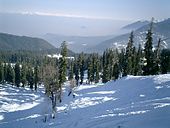 Because of India’s peninsular topography, climatic conditions are widely diversified, ranging from temperate zonal extremes, confined largely to the slopes of the Himalayas, to tropical in most of the remainder of India.
Because of India’s peninsular topography, climatic conditions are widely diversified, ranging from temperate zonal extremes, confined largely to the slopes of the Himalayas, to tropical in most of the remainder of India.
Seasonal variations, resulting from the southwestern and northeastern monsoons, profoundly influence such climatic factors as temperature, humidity and precipitation throughout the subcontinent. Mawsynram gets the highest rainfall in the world.
The Indian climate is strongly influenced by the Himalayas and the Thar Desert, both of which drive the economically and culturally pivotal summer and winter monsoons. The Himalayas prevent cold Tibetan katabatic winds from blowing in, keeping the bulk of the Indian subcontinent warmer than most locations at similar latitudes. The Thar Desert plays a crucial role in attracting the moisture-laden south-west summer monsoon winds that, between June and October, provide the majority of India’s rainfall. Most of India has three seasons: (1) cool (2) hot and (3) rainy.
Cool
The cool season lasts from December through February. The weather then becomes mild, except in the northern mountains. Snow usually falls in mountainous areas during this season. As the altitude increases, temperatures drop below freezing. The northern plains may get some frost during this season. Southern India lacks a true cool season, but the weather from October through February is not quite as hot as during the rest of the year.
 Hot
Hot
The hot season lasts from March to the end of June. The northern plains get the greatest heat. Temperatures often rise to 120 °F. (49 °C). Temperatures on the coastal plains stay around 85 °F. or 90 °F. (29 °C or 32 °C). Cyclones often strike the coastal plains at this time of year. Parts of the southern plateau remain cool during the hot season. The northern mountains are cool or cold, depending on the altitude.
Monsoon
The rainy season lasts from the middle of June through September. During this period, monsoons (seasonal winds) blow across the Indian Ocean, picking up moisture. They reach India from the southeast and southwest, bringing almost all the rain that falls on India. During the other two seasons, monsoons blow from the north or northeast.
The southwest monsoons are of great importance to Indian agriculture. If the monsoons bring enough rain to the country, crops will grow. Sometimes they fail to arrive in time, and crops fail as a result. Some monsoons drop too much rain, ruining crops and causing destructive floods.
Rain falls most heavily in northeastern India. Some hills and mountain slopes in this region receive an average of about 450 inches (1,140 centimeters) of rain a year. The world’s heaviest recorded rainfall for one year fell at Cherrapunji. This place had 1,042 inches (2,647 centimeters) of rain from August 1860 to July 1861 (average is about 425 in). The Thar Desert in the northwestern part of the country receives less than 10 inches (25 centimeters) of rain a year. Some sections of the desert get only about 2 inches (5 centimeters) of rain annually. Mean annual precipitation along the southern slopes of the Himalayas is about 1500 mm (about 60 in).
October and November are the post-monsoon months in India, when skies are cloudless. This post-monsoon season coincides with the northeast monsoon, the effects of which are significant only in some parts of India.
World’s highest Annual Precipitation
Source: US National Climatic Data Center
| Years of record | Continent | Highest Avg (Inches) | Place | Elevation (feet) |
| 38 29 30 32 9 14 22 |
Asia Oceania Africa S.America Australia N.America Europe |
467.4 460 405 354 340 256 183 |
Mawsynram, India Mt. Waialeale, Hawaii Debundscha, Cameroon Quibdo, Columbia Bellenden, Australia Henderson Lake, B.C. Crkvica, Bosnia-Herz. |
4597 5148 30 120 5102 12 3337 |
Note: Llora, Columbia claims to get 523.6 inches of rainfall, according to their own measurement practices, procedures and period, but might not be recognized worldwide
 Extreme conditions
Extreme conditions
India’s lowest recorded temperature was −45 °C (−49 °F) in Dras, Ladakh, in eastern Jammu and Kashmir. Figures as low as −30.6 °C (−23 °F) have been taken in Leh, Ladakh. However, temperatures in Siachen Glacier have fallen below −55 °C (−67 °F), with blizzards bring wind speeds in excess of 250 kmph (155mph) or hurricane-force winds ranking at 12 — the maximum — on the Beaufort scale.
The highest temperature reading was 50.6°C (123.1 °F) in Alwar, Rajasthan in 1955.
India’s highest recorded one-day rainfall total occurred on 26 July 2005, when Mumbai received more than 650 mm (26 in). Kashmir’s highest recorded monthly snowfall occurred in February 1967, when 8.4 metres (27.6 ft) fell in Gulmarg, though the Indian Meteorological Department has recorded snowdrifts up to 12 metres (39.4 ft) in several Kashmiri districts.
Droughts, flash floods, cyclones, avalanches, landslides brought on by torrential rains, and snowstorms pose the greatest threats. Other dangers include frequent summer dust storms, which usually track from north to south; they cause extensive property damage in North India and deposit large amounts of dust from arid regions. Hail is also common in parts of India, causing severe damage to standing crops such as rice and wheat.
